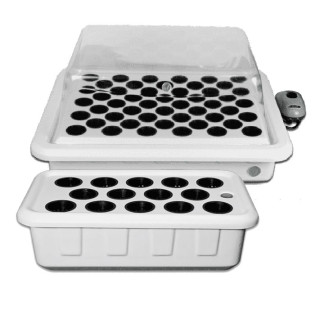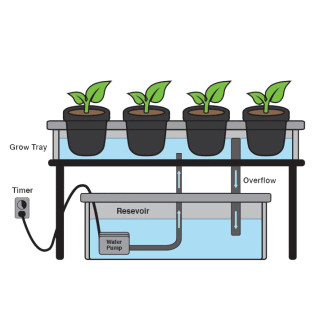
There are lots of reasons to consider growing your own tomato plants, and if this is something you’re interested in, part of this will be learning about cloning tomato plants.
This veggie is juicy, delicious, and versatile - plus, it’s remarkably easy to grow. But did you know that tomatoes have one other fascinating feature - that is, the ability to grow new roots from anywhere along their stem?
It’s true. If you’ve ever wondered what those knobby bumps are that appear along the stems, they're growths that can help you make your own new plants at home.
In this complete guide to how to clone a tomato plant, we'll tell you everything you need to know to make the most of these growths, known as root primordia.
What Does Cloning Tomato Plants Mean?
It sounds like something out of a sci-fi movie, but cloning tomato plants involves no fancy science or technology - and it’s not that scary, either.
In fact, cloning tomato plants is far from a daunting task. It simply involves rooting new tomato plants from leaf cuttings and stems.
Tomato plants are remarkably resilient and have the ability to form new growth when a piece of the existing plant is clipped off and placed into a solution of either soil or water.
As long as you know what you are doing and clip the right part of the plant - and provide the proper care for both the mother plant and cutting once you’ve trimmed it - you can easily clone your own tomato plant.
There are plenty of advantages to doing this, which we’ll discuss in more detail below.
However, the major benefit of cloning tomato plants is that it can save you some serious time and money and allow you to create new plants from the tomato varieties that you love the most.
Advantages Of Cloning Tomato Plants
There are all kinds of benefits to cloning tomato plants. First and foremost is the fact that doing so can save you some serious time and money.
There are all kinds of tomatoes you can grow, including exotic heirloom cultivars, colorful rainbow shades, and even tomatoes that are perfect for making your own homemade sauce.
Growing one of each type can get expensive in a hurry if you’re forced to buy your plants from seed or especially as full-sized larger starts.
Using clones is much more cost-effective, since you’ll grow one large plant and take multiple cuttings from each one.
You’ll get much more bang for your buck in this fashion and it won’t take you as long as if you were to save seeds from each new plant.
What You’ll Need To Start Cloning Tomato Plants

Gather your tools before you begin taking your tomato clones. At the very least, you’ll need a sharp knife or pair of scissors, along with a strong disinfectant so that you don’t risk spreading disease from one tomato plant to the next.
You will also need some rooting hormones - specifically a cloning gel and a cloning solution - along with a grow tray to store your clones in (we'll cover cloning machines in a moment).
You should also have a glass or container of water nearby to store your clones in while you work and to root the clones in later on.
Using A Cloning Machine For Tomato Cuttings
To get the best results possible, you need to use the best cloning machines for this job. You can root your clones in water or soil if you'd like, but there is no beating an aeroponic or hydroponic plant cloner.
These provide the perfect conditions for rooting your cuttings, by splashing water and cloning solution up into the exposed stalk.
These systems speed up the rate at which your plants will root, and increase your success rate. While not every cutting you take will root, you can achieve a higher success rate by using a cloner.
If you don’t want to root in water, you can also root new cuttings in soil. This can speed things up a bit if you're in a hurry.
How to Clone A Tomato Plant

Now, let's teach you what you came here to learn about - how to clone a tomato plant.
There are just a few simple steps you need to follow, and a couple products you should grab to increase your success rate and ensure you have ample clones growing into fresh plants of their own!
Choosing A Mother Plant To Clone
First, you’re going to need to take some cuttings from a “mother” tomato plant - in other words, the plant you wish to create new clones of!
Choose a plant that is large, healthy, and well-established. It should be a plant that you like and that grows well in your climate.
Remember that you will essentially be duplicating this plant's DNA, so don't even think about cloning sick or dismal plants.
Don’t do any pruning to this plant until you’re ready to take your cuttings and consider choosing a mother plant from a local nursery that is proven to do well in your area.
Actually Take Your Tomato Cuttings

Once you have your plant ready to go, you will need to take several suckers as cuttings.
You can use any branch but you’ll have the best luck using new shoots that develop between the intersections of two branches and that form new flowering tops.
You’ll usually prune these suckers anyway, since this will allow the plant to focus all of its nutrients and energy on a smaller number of flowers and to produce healthier, better-tasting fruits.
After you’ve taken the cutting (be sure to use sterilized tools when you do this to avoid spreading disease!) you can put the cutting in a fresh glass of water.
Waiting For New Roots To Grow
Wait one or two weeks, and your new cuttings should sprout new growth. However, using a rooting hormone can help speed up the process, as this hormone will help the plant form roots more quickly.
You can also choose to root your suckers in soil. Prepare the soil by making a hole with a pencil. Bury the cutting up to the lower leaves and then place them in a warm, shaded area indoors or outside.
Allow the suckers to grow until they are roughly a foot and a half to two feet tall and about the width of a pencil.
You can then cut them with a sharp blade, cutting at an angle for a stronger stem. Remove the bottom two sets of leaves so that roots can form.
You can then dip the cuttings in rooting hormones or just the plain glass of water, depending on what you’d prefer.
Caring For & Transplanting Your Tomato Clones
Change the water for your clones every couple of days until new roots have formed. The roots should be about two inches long before you transplant the plants into your garden.
Prune your plants when you transplant, removing any side branches or leaf sets, and bury the cutting fully so that about three-quarters of the plant is underground.
When you transplant, only put the healthiest, strongest tomato clones into the ground.
Plant them in the same place or type of grow media you grew the mother plant, if possible, to make sure they are acclimated to the same conditions.
After a few weeks, you can feed your tomato clones just as you normally would and provide the same standard of care, watering and weeding regularly.
FAQ’s On How To A Clone Tomato Plant
Now, you should know everything there is regarding how to clone tomato plants.
But there are so many other questions we get regarding cloning tomato plants, that we compiled a list of the most frequent ones below.
When Should You Take Tomato Clones?

When taking cuttings, timing is everything. You can take cuttings at any time throughout the year, but it’s best for you to do so in the earlier parts of the growing season so that your plants have plenty of time to mature.
Can Tomato Plants Be Cloned?
You can easily clone a tomato plant. In fact, it’s not difficult to clone a tomato plant so that you can make additional plants for your garden or for your family and friends.
Both tomato suckers along with various stems, branches, and other plant parts easily root in soil or water without the need for much intervention on your part.
How Long Does It Take Tomato Cuttings To Root?
Tomato cuttings root in as little as one to two weeks but may take as long as three to four weeks to become strong enough for transplanting outdoors.
Using a solid rooting hormone and providing the ideal conditions for your clones - warmth and humidity - will speed up this process dramatically.

Will Tomato Cuttings Root In Water?
You can easily root tomato cuttings in water, but using a rooting gel and solution can be effective and more efficient, too.
Rooting gel will help seal off the cut tissue of the plant so that it heals faster and will then provide the hormones that your plant needs to promote root cell development.
Can You Grow Hydroponic Tomatoes?
If you have started thinking about just continuing to grow your tomato clones indoors once they start rooting, you should consider learning how to grow hydroponic tomatoes by reading our complete guide.
This is a unique, advantageous way to grow this vegetable year-round, while producing heavy, great-tasting tomatoes in a more efficient manner. Growing hydroponically should be on every gardener's bucket list!
Where Can I Learn More About Cloning Plants In General?
Cloning plants is a science and an art blended into one. That's why we have a complete guide on how to clone a plant, where you can learn more about this gardening to tactic.
Or, if you don't have the budget to buy a complete cloning system, consider our guide covering how to build a DIY plant cloner - this will save you a ton of money!
Final Thoughts On How To Clone A Tomato Plant
Now that you know how to clone a tomato plant, you can keep an ample supply of this delicious, versatile vegetable on hand year round!
Chances are, you already have everything you need at home - and now you have the knowledge to get started, too!
However, you’ll be much more successful if you arm yourself with the right supplies.
At Hydrobuilder, we have everything you need to propagate and clone your own tomatoes. Shop our full selection of tomato supplies - you won’t be disappointed.
We have everything you need to begin your next grow cycle, regardless of whether you plan on growing indoors or growing outside. Shop today for the best selection and customer service you’ll find nationwide!



























